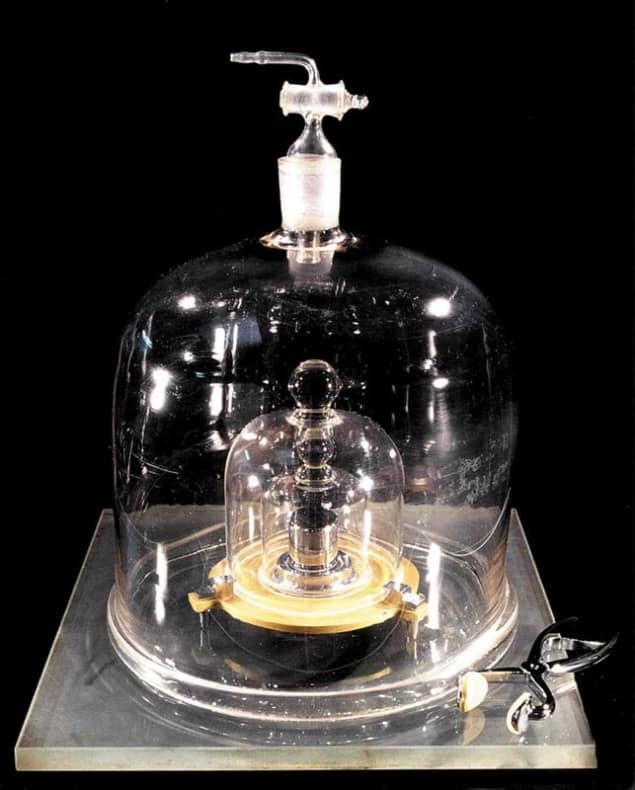Robert P Crease witnesses one of the last inspections of the official SI kilogram standard

Once a year, a century-old ritual unfolds at the International Bureau of Weights and Measures (BIPM) outside Paris. It takes place in the basement of the BIPM’s main lab building, which houses a vault secured with three locks. Three antique keys, held by citizens of different countries, open these locks. At the annual meeting of the BIPM’s governing board – the International Committee for Weights and Measures (CIPM) – the three key holders produce the keys, open the vault, unlock a safe inside the vault and inspect its principal contents: the platinum–iridium cylinder that defines the kilogram.
This year’s ritual, on 13 October, was unusual. It was not just that BIPM director Andrew Wallard (UK) and CIPM president Ernst Göbel (Germany) are retiring, making this their last year as key holders. Nor was it that the third key holder, Claire Béchu of the French Archives, was an hour late, delayed by a strike that snarled French traffic for most of the week. The atmosphere was different because a major change is afoot: the cylinder may soon be removed and dethroned.
End of an era?
The BIPM was created by the Treaty of the Metre in 1875, a landmark in the history of measurement, globalization and international co-operation. The ritual began a few years later when the BIPM’s two international prototypes – of the metre and kilogram – were moved to the safe. In 1960 the metre was redefined in terms of the wavelength of light, thus dethroning the metre bar as the standard. (The metre was redefined again in 1983 in terms of the speed of light.) For most of the rest of the 20th century, metrologists could not even foresee the possibility of similarly replacing the kilogram with a natural standard.
However, advancing technologies now make this not only possible but inevitable. One agenda item at this year’s CIPM meeting, the 99th, was to draft a resolution to be submitted next year to the organization to which the CIPM reports – the General Conference on Weights and Measures (CGPM) – that sets out a plan to redefine the kilogram and three other SI base units. If adopted, all SI units will eventually be defined in terms of natural constants.
In short, the platinum–iridium cylinder may not keep its status in the vault much longer, as it will cease to define the kilogram. Within the next few years, Wallard expects to move it from the safe to a laboratory for measurements in the transition to a new definition.
The 18 CIPM members engaged in last-minute debate on how to phrase the redefinition. Some wanted the language to be aimed at the general public, others preferred technical language for professional metrologists, while still others thought the definition ought to be technical but with accompanying explanations.
In the end, the group agreed on a “statement of intention” to redefine using fundamental constants, but only to proceed when the mise en pratique – in other words, the way in which the definition is to be technologically implemented – is available, agreed and producing consistent results. Furthermore, the group agreed to spread awareness of the potential redefinition and its consequences. Part of this effort will take place at an upcoming meeting of the Royal Society in London next month.
The looming redefinition meant that more than the usual number of spectators lined up to see the kilogram standard; not only CIPM members but BIPM staff and a few invited outsiders, including me. One could not help but be awestruck. For 121 years this cylinder has ruled over an international network of masses and scales that stretches from laboratories in national and local metrology offices into everyday life in the form of grocery stores, post offices and home scales. The cylinder is both a thing and an institution. And its days are numbered.
“It’s so small!” exclaimed many of those who squeezed down the narrow staircase into the tiny room containing the safe. The cylinder is, in fact, a mere 39 mm high and as much in diameter. Another surprise for many of the spectators – including me – was that although the cylinder is protected by three bell-jars, it is not in a vacuum. The prototype turns out to be most stable in air, and might outgas in a vacuum. Spectators excitedly held up cameras and mobile phones to take pictures, the way they do at the Mona Lisa, housed at the Louvre across the Seine. Unlike the Mona Lisa, the international kilogram prototype is unharmed by flash photography – though by my extrapolation, Leonardo da Vinci’s iconic work suffers more photography in 15 min than the prototype does in a century.
The critical point
The CIPM’s draft resolution must still be debated by the CGPM at its 24th meeting in October next year. But two technologies appear on the verge of satisfying criteria for implementation, and the CGPM is expected to take steps towards a revision. “It’s a significant step,” says Wallard. “It would provide, for the first time, an anchoring of all the base units of SI to fundamental constants, from which we can build up the whole system.”
The visitors began to walk back upstairs and headed to the traditional champagne reception in the BIPM’s fabulously beautiful gardens overlooking Paris, with the Eiffel Tower in the distance. Wallard, Göbel and Béchu recorded the temperature and relative humidity, and signed a document attesting that they had verified the presence of the international kilogram prototype and its official copies. They secured the safe, and shut and locked the door of the vault with their three keys, securing the cylinder for what may be its last sovereignty as the ruler of the international network of weights, although it will still have a key role to play in implementing a future redefinition.
The kilogram seemed unperturbed.
• A full feature article on the redefinition of the kilogram will appear in the March 2011 issue of Physics World



